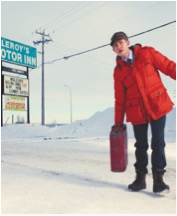COLUMNIST
FX premiered the second season of “Fargo,” a crime anthology inspired by the 1996 Coen Brother’s film this past Wednesday.
The second installment of the anthology opens on the set of a black and white film, “Massacre at Sioux Falls,” where a white director attempts to relate to the movie’s co-star, a Native American actor dressed as a chief. The background is littered with antsy extras portraying massacred American soldiers with arrows in their backs. The cast and crew are waiting for the film’s star, Ronald Reagan.
The scene transitions to 1979, to a place not far from the falls in Fargo, North Dakota. The previous scene seems odd to be placed in a black comedy crime drama, but serves as a way of giving context to life in 1979.
Vietnam vets were returning to life at home, the economy was a mess and America – much like the characters in the previous scene – were waiting for Reagan to save them.
Fargo is a small and snowy town where people say, “oh yah” and “okay then” a lot. Underneath this Upper-Midwestern small town charm lives a dark network of drugs, illegal gambling and murder, run by the Gerhardt crime family.
The Gerhardt patriarch suffers a stroke, opening up a spot for one of his three sons to take over the family business.
His two eldest sons are obvious contenders for the positions, which leaves Rye (Kieran Culkin), the youngest, out in the cold.
Rye is small in stature, has a weasel-like disposition and is easily excitable – the latter of those characteristics likely due to his cocaine habit.
Culkin plays the role of someone dangerously unpredictable with a massive Napoleon complex perfectly.
Rye is the whipping boy of the Gerhardt family but wishes to go out on his own. He devises a scheme to do so, but in order to execute his plan he needs a judge to unfreeze his business partner’s bank accounts.
Rye follows the judge to a Waffle House with intentions of intimidating her into reversing her decision.
The judge is stubborn and confident. During their encounter, she confuses Rye with a biblical metaphor, predicts his cliche threats and then sprays him with an insecticide. This enrages him, so he shoots her.
In a panicked act of desperation, he shoots and kills the waffle house’s cook and waitress, to eliminate any witnesses.
After killing three people, he takes the cash from the register and stumbles out. During his getaway he is distracted by a UFO-like figure in the sky and wanders into the street, getting struck by a passing vehicle.
Country Sheriff Hank Larson (Ted Danson) along with his son-in-law State Trooper Lou Solverson (Patrick Wilson) investigates the gruesome crime scene.
Lou has a wife, who is suffering from cancer, and a young daughter at home. Despite the bitterly cold setting and violent scenes preceding their introduction to the story, the brief glimpse into their home appears warm and safe.
This stark contrast between the grisly murder scene and a scene with a wholesome family is one of many comparisons of good and evil made throughout the episode.
As investigators are attempting to piece together the fragments left behind at the crime scene, the audience is introduced to Ed (Jesse Plemons), a butcher, and his wife Peggy (Kirsten Dunst). They eat a simple dinner of hamburger helper and tater tots while making conversation about their future plans.
A loud thud sends Ed into their garage where he discovers that Peggy has crashed her car. In an even more shocking twist, he discovers a bloody and angry Rye in the garage as well.
With anthology-style dramas, it can be difficult to maintain quality and interest, as was evident with this summer’s laughably disappointing season of “True Detective.” The sophomore season of “Fargo” has already surpassed the reputation its first season built for the series.
The story shifts focus several times throughout the premiere and leaves the audience desperate to join Fargo’s journey to defend itself against the evil that pervades the small town like cancer.

